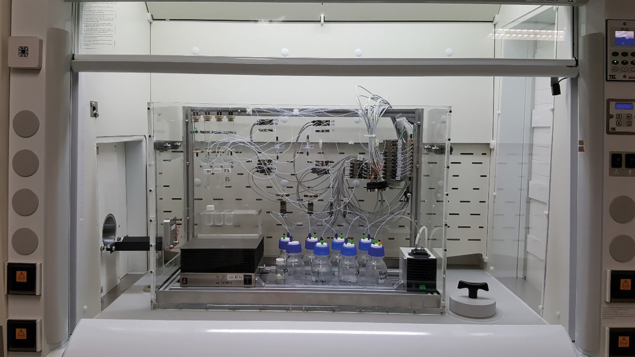Pakistan’s domestic effort to scale up commercial production of medical radioisotopes taps into a productive R&D collaboration with CERN’s MEDICIS facility, as Moazam Mehmood Khan, Umair Khalid, Zafar Yasin and Shabana Saeed explain.

The Pakistan Atomic Energy Commission (PAEC) provides a focal point for the country’s diverse scientific, technological and engineering collaborations with CERN and other leading international accelerator facilities. Zoom in a little further and one of the engine-rooms for that collaborative endeavour is very much front-and-centre: the Pakistan Institute of Nuclear Science & Technology (PINSTECH).
Headquartered in Islamabad, PINSTECH is a premier R&D institute within PAEC and, by extension, one of Pakistan’s leading research centres. The institute’s wide-ranging research programme spans, among other things, isotope production and applications, materials science, radiation protection and health physics, as well as neutron science. That R&D effort is augmented by two operational nuclear research reactors: Pakistan Research Reactor-1 is a 10 MW pool-type reactor which is used to produce radioisotopes for medical applications; Pakistan Research Reactor-2 is a smaller reactor that’s used, chiefly, for neutron activation and teaching/training activities.
Operationally, PINSTECH has facilities for the production of a range of reactor-based radioisotopes – including 99Mo, 99mTc generators, 131I, and 32P – all of which are supplied to nuclear medicine centres across the country on a rolling basis. A key element of this programme is PINSTECH’s production of freeze-dried, radiopharmaceutical in-vivo diagnostic kits for nationwide distribution.

During radioisotope production, target materials are placed into the research reactor for neutron irradiation, after which the irradiated targets are transferred into the “hot cells” of the facility for chemical separation, purification, quality control and dispatch. The Pakistan Nuclear Regulatory Authority and Drug Regulatory Authority of Pakistan regulate the end-to-end production process.
Elsewhere within PINSTECH, and with support from CERN, researchers are developing a 5 MeV electron linac for radiotherapy applications – part of a national effort to scale technical capacity and capability in medical accelerator technologies.
Radioisotope collaboration
Collaboration is hard-wired into PAEC’s operational model and, as such, underpins Pakistan’s radioisotope production programme. PAEC and the International Atomic Energy Agency (IAEA), for example, have been working together in this area for many years and have completed a number of successful technical cooperation projects (with a joint project in the healthcare sector currently under way at the national level).

CERN is another flagship R&D partner, with PINSTECH and the CERN–MEDICIS facility engaged in a cooperative effort focused on the production and study of innovative radioisotopes for medical diagnostics and treatment. Specifically, the two organisations are carrying out R&D activities on the production of novel medical (reactor- and accelerator-produced) radioisotopes such as 195mPt, 165Er, 225Ac, 155Tb, 161Tb, 177Lu – an endeavour, the two partners hope, that will ultimately extend to clinical trials. The bottom line is that Pakistan, which has high cancer mortality and morbidity within its population of 220 million, is keen to take advantage of cutting-edge radioisotope science for the at-scale diagnosis, treatment and management of cancer patients.
CERN and Pakistan: better together
The Islamic Republic of Pakistan became an Associate Member of CERN in 2015, formalising a relationship going back much further. For context, Pakistan and CERN signed a cooperation agreement in 1994, followed by the signing of several protocols. Today, Pakistan’s scientists and engineers contribute to the ALICE, CMS, ATLAS and MEDICIS experiments; that engagement has also included accelerator projects such as CLIC/CTF3 and LINAC4.
On CMS, Pakistan played an important role in the tracker alignment; built and installed 320 resistive plate chambers; and assembled and tested gas electron-multiplier detectors. Other notable contributions have included CMS and ALICE computing, the WLCG and data analysis, as well as operating one of the Tier-2 centres. Currently, Pakistan is contributing to the mechanics and electronics of the HGCAL of the CMS as well as engaging on the tracker upgrade. Teams from Pakistan also built critical parts of the experimental infrastructure, including the feet on which the whole barrel yoke stands; the outermost end-cap disks; and the removable tower supporting the forward hadron calorimeter.
In addition, Pakistan has built various mechanical components for ATLAS and for the LHC and made an important contribution to the LHC consolidation programme in 2013–2014.
Knowledge transfer
With this in mind, PINSTECH scientists and engineers have been seconded to the CERN–MEDICIS team for the development of radiochemical activities – including a major contribution to the MEDICIS radiochemistry set-up for the purification of medical radioisotopes with both therapeutic and diagnostic properties (so-called “theranostic” combinations). PINSTECH engineers have also been working on the development of salt/aluminium foils for radio-isotope collection; the management of liquid radioactive waste at MEDICIS; a very promising R&D project relating to the production of 195mPt for theranostic applications; and the development of a large-scale radiochemistry unit for handling higher levels of radioactivity.
Fundamental to the PINSTECH-MEDICIS collaboration is the regular exchange of radioisotopes between the two partners. As an example, research quantities of 225Ac were recently shipped from CERN to Pakistan and, after chemical processing at PINSTECH, transferred to the Lahore-based INMOL cancer clinic (another PAEC facility). Here the 225Ac was used in the radiolabelling of a targeted “theranostic module” (with the chemical reaction to produce the radiopharmaceutical taking about 30 mins with a yield greater than 95%).
For Pakistan, opportunity knocks, with the R&D collaboration between PINSTECH and MEDICIS key to the country’s long-term goal of strengthening the technical capability, commercial capacity and production infrastructure to secure a scalable domestic pipeline of novel and high-impact theranostic radioisotopes.







